 Image search results - "gun" Image search results - "gun" |
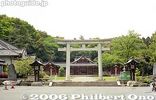
To Kannon-yama
|
|

The Kannon statue peers over the trees.
|
|

Entrance and stairs going up to Shorinzan, a small hill. 少林山
|
|
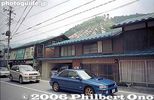
Held during late April to early May, Kanna's Koinobori festival of carp streamers is this town's claim to fame. About 800 colorful carp streamers swim in the sky above a river. Strings of carp streamers viewable from the road.
|
|
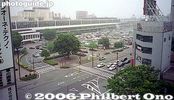
JR Takasaki Station 高崎駅As seen from my hotel.
|
|
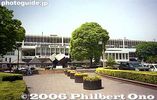
JR Takasaki Station
|
|

Standing 41.8 meters high, equivalent to a 9-story building.
|
|
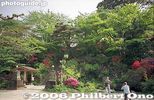
Garden
|
|

Strings of carp streamers latched to the ground from the mountaintop.
|
|
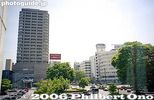
View from JR Takasaki Station's East Exit. 高崎駅東口Takasaki Tower Museum of Art is the tall building on the left.
高崎市タワー美術館
|
|

Built in 1936.
|
|
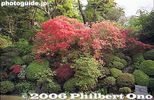
Garden (photos taken in early May)
|
|
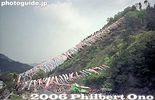
Eight strings of carp streamers hover over the river.
|
|

JR Takasaki Station, West Exit 高崎駅西口
|
|

Made of concrete.
|
|
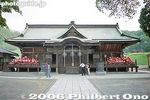
Shorinzan Daruma Temple 少林山達磨寺Daruma offerings on both sides of the temple.
|
|
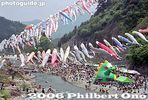
These pictures were taken in May 2003, when Kanna-machi town was newly formed upon the merging of Manba town and Nakazato village.
|
|
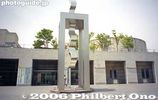
Takasaki Museum of Art 高崎市立美術館
|
|
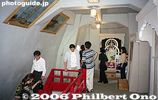
One of 20 Buddha figures inside the Kannon.During New Year's, many people visit the Kannon.
|
|

An Australian praying at the temple
|
|
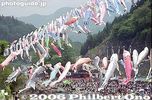
I would say this is one of Japan's top five best places to see carp streamers at Kanna-machi, Gunma.
|
|
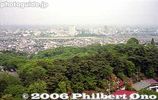
View from Kannon-yama.
|
|
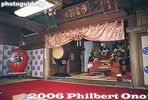
Inside the Daruma temple, Takasaki.
|
|

Kanna-machi is quite out of the way, but worth the time it takes to get there (from Takasaki).
|
|
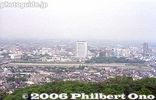
View of Takasaki. The tall building is Takasaki City Hall.
|
|
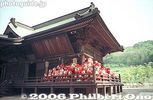
Right balcony of temple.
|
|

Parking lot downstream. Most people arrive by car or bus. (No nearby train station.)
|
|

Right balcony of temple.
|
|
|
|
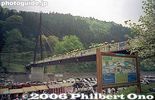
Bridge with a view
|
|
|
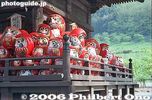
Right balcony of Daruma temple, Takasaki.
|
|

In Japan, the koi carp is regarded as a symbol of valiant manhood because it swims up the river against the rapids.
|
|
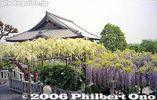
Wisteria
|
|
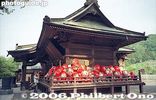
Right balcony of temple.
|
|
|
|
|
|

Right balcony of temple.
|
|

Riverside
|
|
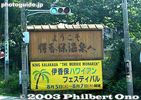
Ikaho is also a sister city of Hawaii island. During Aug. 5-7, 2003, Ikaho hosted the 7th King Kalakaua Merrie Monarch Hawaiian Festival featuring hula performances by numerous Japanese hula groups.
|
|

Kannon and bridge, Takasaki, Gunma
|
|

Right balcony of Daruma temple, Takasaki
|
|

Swimming in the air
|
|
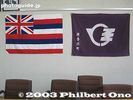
In the evenings, Hawaii's top hula halau (winner of the Merrie Monarch Festival in Hawaii) performed as the festival's main event. Photo: Flags of Hawaii and Ikaho town (merged with Shibukawa in 2006).
|
|
|

Daruma closeup
|
|
|
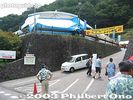
Town parking lot with a makeshift stage and main venue of the festival. The "Merrie Monarch" refers to King David Kalakaua who reigned over the Hawaiian Kingdom 1874-1891. He promoted hula in Hawaii as well as Japanese immigration to Hawaii.
|
|

Left balcony of temple.
|
|
|
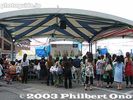
Canopy for the spectators fronting the main outdoor stage.
|
|
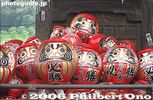
Daruma dolls can never be knocked over since they always stand upright.
|
|
|
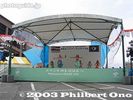
Main stage where many Japanese hula troupes performed during the day for three days. Free admission.
|
|
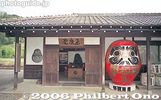
Daruma Museum (next to temple)
|
|
|
|
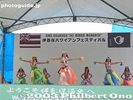
Tahitian dances were also performed.
|
|
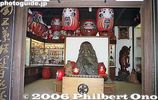
Entrance to Daruma Museum (one room only)
|
|
|
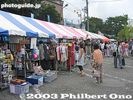
Hawaiian souvenirs for sale.
|
|

Daruma exhibits (the giant daruma on the left is for the late Fukuda Takeo, former prime minister from Gunma.
|
|
|
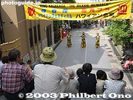
Ikaho is famous for the Stone Steps lined with shops. A section of it also served as a second hula stage during the day.
|
|

The giant daruma on the left is for Nakasone Yasuhiro, and the right is for the late Obuchi Keizo, both former prime ministers from Gunma.
|
|
|

Hula on the Stone Steps 石段街
|
|

Different daruma from all over Japan. Very interesting.
|
|
|
|
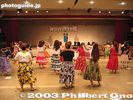
Hula workshops are also offered during the day at cost. A famous kumu hula teacher from Hawaii teaches the class.
|
|
|
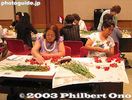
Other workshops are held such as ukulele lessons and a lei-making class.
|
|
|
|
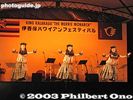
In the evenings, the overall winner of the annual Merrie Monarch Festival in Hawaii performed on stage. In 2003, it was Hula Halau 'O Kamuela from Oahu. They performed both the ancient hula kahiko dances (pictured here) and modern auana dances in Ikah
|
|
|
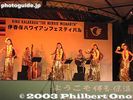
The Ikaho hula festival is officially sanctioned by The Merrie Monarch Festival, held in spring in Hilo, Hawaii. It is the most important and prestigious hula competition.
|
|
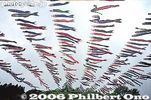
Eight strings x 100 carp streamers = 800 carp
|
|
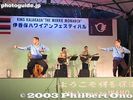
Hula is also performed by men. These photos were taken during the 7th Ikaho Hawaiian Festival (Aug. 5-7, 2003).
|
|
|
|

Carp streamer caught at Kanna-machi, Gunma
|
|
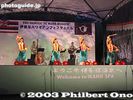
They wore a variety of colorful costumes and used various hula instruments such as these frayed bamboo sticks called Pūʻili.
|
|

Lying low
|
|
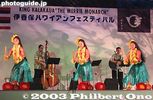
Modern hula dances such as this one is mainly for tourist entertainment.
|
|
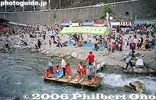
Raft rides
|
|
|
|
|
|
|
|
|

After the bamboo sticks, the girls used a gourd drum called ipu.
|
|

Ground connection
|
|
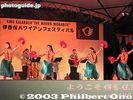
Finally, they use feathered gourd rattles called Ulīʻulī.
|
|

Ground connection: Cable anchor for one string of carp
|
|
|

Cables go all the way up the mountain.
|
|
|

There's a secret technique to fasten the carp to the cable so they don't slide around.
|
|

They are professional hula dancers, some of the best in the world.
|
|
|
|

The kumu hula is Kamana'o Anson Kauionalani or Kaui for short. He does a solo dance here. The music was performed by a wonderful Hawaiian trio called 'Ale'a.
|
|
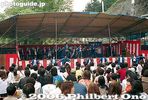
Entertainment on stage
|
|
|
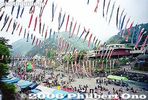
Hiking up the mountain.
|
|

Hiking up the mountain.
|
|
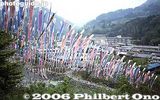
View from halfway up.
|
|
|

The wind died.
|
|
|
|
|
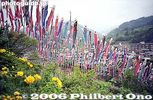
The mountain is an easy hike. But hardly anybody climbed it.
|
|

Superb views from the mountain.
|
|
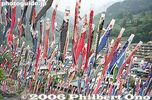
The mountain top has a small rest house.
|
|
|
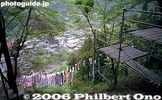
Top of the mountain
|
|

Cable anchor
|
|

View from mountain top, Kanna-machi town seen below.
|
|
|
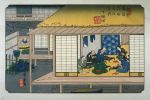
Hiroshige's woodblock print of Takasaki (30th post town on the Nakasendo) from his Kisokaido series.
|
|
|

Going down
|
|
|
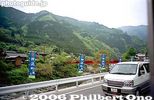
Bus back to JR Shin-machi Station, takes about 90 min.
|
|
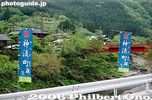
Kanna-machi banners celebrating the formation of the new town.
|
|

JR Shin-machi Station to go back to Takasaki.
|
|

Bus we rode to and from Kanna-machi.
|
|
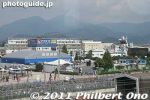
Shizuoka Hobby Fair site as seen from Higashi Shizuoka Station. The giant Gundam statue is clearly visible.
|
|
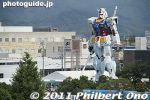
Giant Gundam statue is clearly visible from Higashi Shizuoka Station.
|
|
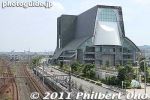
Also visible from the station is Granship, the Shizuoka Convention & Arts Center.
|
|
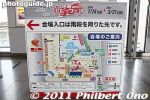
Sign pointing the way to the Shizuoka Hobby Fair.
|
|
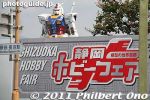
Gundam looms over Shizuoka Hobby Fair sign.
|
|
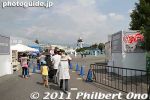
Entrance to Shizuoka Hobby Fair.
|
|
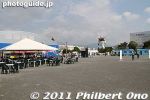
Straight ahead is Gundam and on the left is a pavilion.
|
|
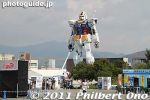
The giant Gundam is the main attraction by far.
|
|
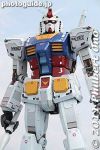
Giant Gundam with eyes aglow at Shizuoka Hobby Fair 2010-2011.
|
|
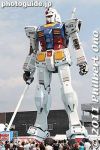
He can even turn his head. This show occurs every 30 min.
|
|
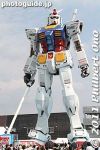
He turns his head back.
|
|
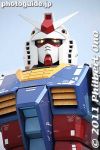
Unfortunately, he couldn't walk or fly.
|
|
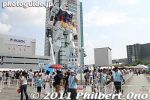
There was a long line to get a closer look and pass under the statue.
|
|
|
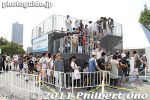
A lookout deck for Gundam.
|
|

Rear view of Gundam.
|
|
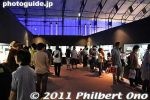
Inside the hobby pavilion were exhibits of numerous plastic models.
|
|
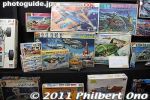
Plastic models on display.
|
|
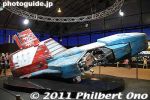
Life-size spaceship.
|
|
|
|
|
|
|
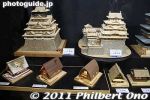
Castle models.
|
|
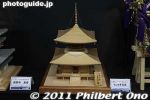
Ishiyama-dera Tahoto pagoda model.
|
|
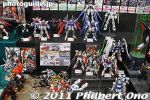
Gundam models
|
|

Higashi Shizuoka Station.
|
|

Main venue of the Ikaho Merrie Monarch Hawaiian Festival held every summer in Ikaho Spa, Gunma Prefecture since 1997. It is on a city-operated parking lot. 伊香保ハワイアンフェスティバル会場
|
|

The main venue has two large adjoining tents. The tent on the left covers the stage, and the one on the right covers the audience seats. The place is ringed by outdoor shops selling Hawaiian goods (mainly clothing).
|
|

About 600 seats at the main venue. Ikaho's connection to Hawaii lies with the summer residence of Robert Walker Irwin, the Hawaiian Minister to Japan during the late 19th century.
|
|

The Hawaiian festival's opening ceremony was held on the festival's first day on Aug. 3, 2008. Among Japan's many hula festivals, this one is unique since it is organized by a city government based on sister-city ties.
|
|

The opening ceremony included a few speeches and a ukulele performance by Mr. San'uemon Chigira, the chairman of the festival committee.
|
|

Short greetings by Luana Saiki-Kawelu, Assistant Director of the Merrie Monarch Festival in Hilo, Hawaii. Ikaho's Hawaiian festival is Japan's only hula event officially endorsed by the Merrie Monarch Festival in Hilo.
|
|

A few words by Kau'i Kamana'o, kumu hula of Hula Halau 'O Kamuela who was the festival's guest performer and overall winner of the 2008 Merrie Monarch Festival in Hilo, Hawaii.
|
|

Kumu hula Kunewa Mook also speaks at the opening ceremony. In the background is the flag of the city of Shibukawa. In Japan, all cities, towns, and villages have their own official logo and flag.
|
|

Kumu hula Aloha Dalire, instructor of the Hawaiian seminars during the festival, also greets the audience. アロハ・ダリレ
|
|

Thomas Goya, from Hilo and president of the Japanese Community Association of Hawaii, speaks as a representative of the County of Hawai'i, Ikaho's sister city. ハワイ島日系人協会会長
|
|
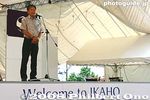
Tommy Hirano, Honorary Consul-General of Japan from Hilo, Hawaii also speaks. It was his first visit to Ikaho.
|
|

Signboard at the entrance to Ikaho Spa. ("Monach" is spelled wrong.) "Monach"はスペルミス。
|
|

Main venue of the Ikaho Hawaiian Festival. メイン会場
|
|

Shops around the main venue.
|
|

More shops on the lower level.
|
|
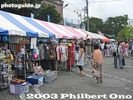
Shops on the lower level.
|
|

During Aug. 3-6, 2008, about 390 hula groups (totaling 4,700 people) performed on this stage. About 838 hula groups applied to perform, and only 390 could be selected to appear.
|
|
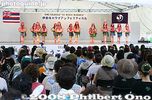
Every 4 minutes, a new group of hula dancers went on and performed on stage. This went on for four days 10 am to 6 pm (except on the first day when it started from 1 pm).
|
|

The first day featured Keiki Hula (hula by children).
|
|

Once upon a time, hula in Japan was mainly done by elderly women. Not anymore as hula's popularity has spread to all ages in Japan.
|
|

All the seats were filled during the all-day performances. So many hula groups applied to perform during the festival that Ikaho had to draw lots to decide who could appear.
|
|

For many women, hula is good exercise, recreational fun, or a chance to look and feel like a different person. The colorful costumes, flowers, attractive movements, and glamorous setting are all very appealing.
|
|

Kupuna 4分ごとに各フラチームがステージで出演。
|
|

The famous Stone Steps of Ikaho. Ikaho is on a mountain slope, and the Stone Steps goes through the center of the hot spring town. It is lined with shops and inns. ("Monach" is spelled wrong.) "Monach"はスペルミス
|
|

One section of the Stone Steps also served as another venue for Ikaho's Hawaiian Festival. 「街角フラ」石段にて
|
|

This venue is called "Machikado Hula." (Street corner hula). It went on from 11 am to 5 pm during the four-day festival (except on the first day when it started from 1 pm).
|
|

The audience sit on the Stone Steps to watch the "Street corner hula." So what did they do when it rained?
|
|

A few hula dancers take a break after performing their number on the Stone Steps.
|
|

A total of five 90-min. Hawaiian seminars were held during Ikaho's Hawaiian festival in Aug. 2008, and they were all taught by kumu hula Aloha Dalire who was very well received by the (thrilled) students.
|
|

Kumu hula Aloha Dalire explains that she is a 7th-generation kumu hula in her family, and produced five Miss Aloha Hulas at the Merrie Monarch Festival in Hilo, including all three of her daughters and Kuhi Suganuma, the 2008 Miss Aloha Hula.
|
|

Aloha Dalire taught seminars in hula history, Hawaiian expression, and lei-making (pictured here). She brought a boxful of a'ali'i flowers for lei-making. All the students had heard of the flower, but it was the first time for them to see it.
|
|

Aloha also taught two hula workshops. For the first workshop, she taught the song "Nani Lawa'i" (sung by Na Palapalai). First, she had the students close their eyes and listen to the song.
|
|

Aloha Dalire teaching hula in Ikaho. The Hawaiian workshops were held at the Ikaho Kaikan Hall in central Ikaho. アロハ・ダリレが教えるフラセミナー
|
|

For the second hula workshop, Aloha taught the song "Nani Manoa." The workshops were held at Ikaho Kaikan hall. 伊香保会館
|
|
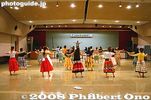
It cost 30,000 yen to take all five seminars or 10,000 yen for one seminar. The hula seminars were the most popular. Free ukulele lessons were also taught at a different venue by a Japanese teacher.
|
|

Students who attended all five Hawaiian seminars were given a Certificate of Completion signed by Aloha Dalire who enjoyed teaching the seminars. She then freely signed autographs and took pictures with the students.
|
|

From 7 pm to 8:30 pm, the Hawaiian Waiwai Party allowed anybody to go up front and dance the hula. Hawaiian music provided by a Japanese Hawaiian band (Dan Yamamoto & Ikaho Hawaiians).
|
|

Hawaiian Waiwai Party ("Waiwai" means boisterous.)
|
|

After the Waiwai Party was a nightly drawing for prizes. People staying at any Ikaho inn/hotel would receive a lottery ticket which they put in this large box. The grand prize was a trip for two to Hawaii. The prize drawing was held on all four nights.
|
|

Guests of Honor from Hawaii were introduced to the crowd.
|
|

The nightly main event was an hour-long Merrie Monarch hula show by Hula Halau 'O Kamuela, the overall winner of the 2008 Merrie Monarch Festival held in Hilo, Hawaii.
|
|

Every year, the overall winner of the Merrie Monarch Festival is invited to perform at Ikaho's Hawaiian festival. They started with a hula kahiko (ancient hula) dance.
|
|

This was a song about paddling a canoe, I think.
|
|

Dreamy stage lighting.
|
|

Colorful costumes and lots of eye candy.
|
|

Crowd-pleasing performance.
|
|

Kumu hula Kau'i Kamana'o does a solo number.
|
|
|

On the last day of the festival on Aug. 6, 2008, a closing ceremony was held at 8 pm before the prize drawing and Merrie Monarch Show. Luana Saiki-Kawelu gives a few words.
|
|

Aloha Dalire also speaks during the closing ceremony.
|
|

Thomas Goya during the closing ceremony.
|
|

Tommy Hirano during the closing ceremony.
|
|

The Honorable Jiichi Kogure, mayor of Shibukawa, lauds the festival during the closing ceremony. 渋川市長 木暮治一
|
|

Mayor Kogure speaks with Aloha Dalire and Luana Kawelu after the Merrie Monarch Show.
|
|

On the last night of the festival, a farewell party was held for the Hawaii delegation. Shibukawa city council chairman Katsuaki Oshima (left) and Mayor Kogure pose with members of Hula Halau 'O Kamuela.
|
|

Members of Hula Halau 'O Kamuela try Japanese-style dancing during the farewell party.
|
|

Group shot of the Hawaii gang and Ikaho Hawaiian Festival Committee.
|
|

Hawaiian celebrities Aloha Dalire and Luana Kawelu pose with yet another group of Japanese hula dancers in a hotel lobby in Ikaho.
|
|
|
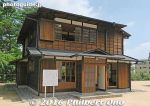
Robert Walker Irwin's summer residence in Ikaho, next to the Stone Steps. He was the Hawaiian Minister to Japan during the late 19th century. He coordinated the immigration of Japanese to Hawaii. ロバート W. アルウイン別邸
|
|

In 1985, the 100th anniversary of the Japanese immigration to Hawaii, Ikaho designated this residence as one of the town's Historic Places. ハワイ王国公使別邸
|
|

This modest building is only part of what was a larger complex of Irwin's summer residence. This is the front entrance. Open to the public, free admission.
|
|

Robert Walker Irwin's summer villa was moved to its present and original location in fall 2013. Map here.
|
|

If the house is boarded up like this, it's probably closed. The Irwin house is closed on Tuesdays.Getting here: From the Buster Shinjuku bus terminal at JR Shinjuku Station (near South Exit) in Tokyo, there are JR buses to Ikaho, taking 2.5 hours. Get off at the Ikaho Ishidangai stop (伊香保石段街) at the bottom of the Stone Steps. Day trippers can store luggage in the nearby lockers. Irwin's villa is a short distance up the Stone Steps on the right side.
|
|
|
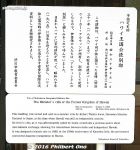
About the "Minister's Villa of the Former Kingdom of Hawaii" ハワイ王国公使別邸 (英語がちょっと変)地元の子供達の英語教育を担当している教育委員会の英文は特にしっかりしたものにして欲しいですね。こんな英語で手本にもならないし、英語の勉強にもならない。読む外国人さんも笑わせる。
|
|

The Irwin house and museum are open 9 am to 4:30 pm (enter by 4:15 pm). Closed Tuesdays and Dec. 28–Jan. 4.
|
|

First floor of Robert Walker Irwin's summer residence in Ikaho. When the house was moved, it was disassembled and repaired before reassembly.
|
|

This first floor originally had tatami mats. You still need to take off your shoes to enter.
|
|

Robert Irwin spent his summers in Ikaho from when he bought the villa in 1891 until 1925 when he died. It was an inn when he bought it.
|
|

Second floor has tatami mats. The second floor is open to the public only on weekends and during the hula festival in summer.
|
|

After Irwin bought the house, he fixed it up by reinforcing the walls against earthquakes with diagonal beams.
|
|

After Irwin died, the house was sold to Kodansha, a publishing company, and used for employee training. Eventually, the house was acquired by Gunma Prefecture and later by Ikaho/Shibukawa.
|
|
|
|
|
|

Second floor
|
|

View of garden from second floor.
|
|
|

The Irwin house is on the left, and a small museum called the Guidance Facility is on the right.
|
|

Map of the Irwin Park.
|
|
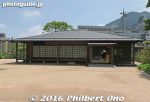
Irwin house Guidance Facility, a small museum showing Irwin artifacts.
|
|
|

Guidance Facility
|
|

The Irwin Guidance Facility has exhibits about Robert Walker Irwin, his Hawaii connection, and his life in Ikaho. A short video introduces him here.
|
|

A young Robert Walker Irwin.
|
|
|

Main exhibits on the left. No English as of July 2016.
|
|

They don't allow photography inside the museum.
|
|

Panel explaining Japan-Hawaii relations.
|
|

Items related to the Japanese immigration and Japanese-Americans in Hawaii.
|
|
|

Koa calabash bowl from Hilo, Hawaii to mark Ikaho's 100th anniversary in 1989.
|
|

Various printed matter related to the Japanese immigration and Japanese-Americans in Hawaii.
|
|

Booklet from Lorraine Inouye, then mayor of the Big Island.
|
|

Newspaper article about King Kalakaua's visit to Japan.
|
|

Panel about Robert and wife Takechi Iki.
|
|
| 1011 files on 5 page(s) |
1 |
 |
 |
|